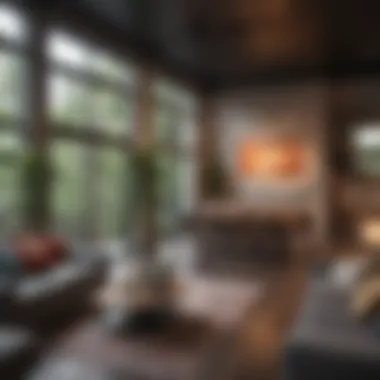Exploring Co-Living in Austin: A Comprehensive Insight


Intro
Co-living in Austin is becoming increasingly popular among various demographic groups. This housing trend facilitates a communal lifestyle, appealing especially to young professionals, students, and even retirees seeking a vibrant community experience. In this article, we will explore the nuances of co-living in Austin, including its design features, community dynamics, financial considerations, and the implications for the local real estate market.
Home Features
In co-living spaces, the design and layout are critical to fostering a sense of community while maintaining individual privacy. The architectural aspects often blend modern aesthetics with functionality.
Architectural Marvels
Austin is known for its eclectic architectural styles. Many co-living spaces embody this diversity. For example, buildings designed by firms like Studio Gang exemplify sustainable architecture. They use natural materials and large windows, allowing ample light while promoting energy efficiency.
Some examples include:
- Spacious communal areas that encourage interaction among residents
- Private rooms with en-suite bathrooms for personal comfort
- Rooftop gardens or communal terraces that promote outdoor activities and social engagement
Unique Design Elements
Interior design plays a pivotal role in the overall ambiance of co-living spaces. Many developers prioritize creating inviting environments. Neutral color palettes along with greenery help to foster a calming atmosphere.
Key design elements often include:
- Shared kitchens equipped with high-quality appliances, fostering a communal cooking experience
- Cozy lounges designed for relaxation and socializing
- Versatile workspaces that cater to remote professionals
Interior Design Inspirations
The space's interior impacts the lifestyle of its residents significantly. Thoughtful design enhances the living experience and contributes to productivity and wellbeing.
Color Palettes and Themes
Colors influence mood and functionality in co-living spaces. Designers frequently opt for soft tones or muted colors, as these create a serene environment. Themes might range from minimalistic to bohemian, depending on the target demographic.
Furniture Arrangement Tips
Arranging furniture effectively can maximize both social interactions and personal space. Often, designers emphasize:
- Open-plan layouts that connect living areas while offering zones for privacy
- Multi-functional furniture to optimize space
- Strategically placed communal tables to foster engagement among residents
"The design of a co-living space can either enhance or inhibit the community experience."
As we continue to explore this topic, it is essential to consider how co-living shapes the lifestyle of residents and impacts the broader Austin real estate scene.
Foreword to Co-Living
Co-living is becoming increasingly relevant in today’s fast-changing housing market. In cities like Austin, where population growth is significant, co-living offers a modern solution to those seeking community, convenience, and affordability.
Defining Co-Living
Co-living refers to shared living arrangements where individuals or groups reside in a single building or property, having their private space but sharing common areas. This setup often aims to foster a sense of community among residents. It typically comprises features like fully furnished rooms, shared kitchens, and recreational spaces, designed to enhance interactions while ensuring individual privacy. The rise of this trend emanates from the growing need for more accessible living options in urban areas, especially amid changing economic conditions.
Historical Context and Evolution
The concept of co-living is not entirely new; it has roots in communal living practices that date back centuries. However, its modern iteration has seen a significant shift since the early 2000s, driven by factors such as urbanization, a surge in remote work, and rising housing costs. Initially popular among students and young professionals, co-living has evolved to attract a diverse demographic, including families and retirees. In Austin, this change is reflected in various innovative living spaces catering to distinct resident needs. Understanding its historical development provides important insight into why co-living resonates today, particularly in urban centers where traditional housing options are increasingly inadequate.
"Co-living is not merely about sharing space; it represents a lifestyle choice that values community and connection in an often isolating urban environment."
This examination of co-living lays the groundwork for deeper investigations into its dynamics and implications within the context of Austin.
The Austin Context


The Austin context plays a pivotal role in understanding the rise of co-living spaces in this flourishing city. Austin is known for its vibrant culture, strong economy, and a youthful population that is constantly evolving. As the city continues to grow, so do the demands for innovative living arrangements that cater to the needs of diverse demographic groups. Many individuals and families are finding traditional housing options increasingly unattainable. Here, co-living emerges as a viable solution.
Demographic Shifts in Austin
The demographic shifts in Austin have been significant over the past decade. The city has attracted a large influx of tech professionals, artists, and young families seeking a high quality of life. According to the U.S. Census Bureau, Austin has consistently ranked among the fastest-growing cities in the United States. This rapid growth has resulted in a diverse population with various socio-economic backgrounds, influencing the need for flexible and affordable living arrangements.
Particularly, millennials and Generation Z individuals are driving this change. They often prioritize experiences over possessions and tend to favor locations that allow for social connections. Such shifts lead to the rising popularity of co-living spaces that offer not just housing but also opportunities for community engagement. By providing shared living environments, co-living addresses the need for balance between privacy and connectivity.
Real Estate Trends in Austin
The real estate market in Austin reflects these demographic trends. The demand for housing in this region has surged, leading to an increase in property values. The competition for traditional homes is fierce, pushing many potential buyers to consider different options. Consequently, developers are now focusing on co-living projects that cater to the changing needs of residents.
In particular, the rise of co-living spaces signifies a shift away from conventional apartment complexes. These developments often feature communal areas designed to foster connection among residents. Amenities like co-working spaces, fitness centers, and common lounges are now standard in many co-living projects. This transition is important not only for meeting housing demands but also for creating environments that support the unique Austin lifestyle.
The evolution of the Austin housing market underscores the importance of co-living as an alternative to traditional real estate options, addressing affordability and community needs.
Overall, the Austin context is a crucial pillar in understanding the co-living phenomenon. The intertwining of demographic shifts and real estate trends shapes the landscape, making co-living an attractive option for many of the city’s residents.
Co-Living Spaces in Austin
Co-living spaces in Austin are not only a trend but a substantial shift in urban living. They offer a blend of community, affordability, and convenience that traditional housing often lacks. As a vibrant city with a growing population, Austin has seen an increase in demand for unique living arrangements. This demand is met through various co-living developments that cater to diverse needs and lifestyles.
Popular Co-Living Developments
Several notable co-living developments exist in Austin, reflecting the city's character and its residents' preferences. Among these, developments such as Common, WeLive, and Roam have gained attention. Each of these offers distinct features and vibes, making them attractive for potential residents.
- Common focuses on providing fully furnished spaces integrated with a sense of community. They often host events, allowing for networking and social interactions among residents.
- WeLive, an extension of the WeWork brand, caters mainly to young professionals and digital nomads. Its amenities and services aim to attract individuals looking for a blend of work and lifestyle.
- Roam emphasizes flexibility with its terms and community-oriented living. It’s a popular choice for those who travel frequently but still desire a home base in Austin.
This variety showcases the adaptability of co-living spaces to the diverse population of Austin.
Design Aesthetics and Amenities
Austin's co-living spaces are marked by thoughtful design aesthetics and comprehensive amenities that enhance the resident experience.
Functional Design
Functional design is crucial in co-living spaces. It prioritizes practicality while ensuring residents feel at home. Key characteristics include:
- Space Utilization: Functional designs make the most out of limited space through smart layouts and multi-use furniture. This trait is particularly appealing in urban environments.
- Comfort: Functional spaces blend comfort with style, ensuring a pleasant living experience.
A unique feature of functional design in Austin’s co-living spaces is open-plan layouts that promote interaction among residents. This can be advantageous as it fosters community while allowing for personal privacy within individual rooms.
Shared Spaces
Shared spaces are a hallmark of co-living. They contribute greatly to the overall community feel and enhance social interactions. The key characteristic here is:
- Collaboration: Shared kitchens, lounges, and workspaces allow residents to collaborate, share ideas, and build friendships.
These spaces often feature cozy furnishings and communal activities that draw individuals together. A unique feature of shared spaces in Austin’s developments is their integration with outdoor areas, allowing for gatherings in pleasant weather, further boosting the community spirit.
Sustainability Features
Sustainability features are increasingly important in modern co-living spaces. They contribute to a more eco-friendly lifestyle, appealing to environmentally-conscious individuals. Key aspects include:
- Energy Efficiency: Many co-living developments in Austin utilize energy-efficient appliances and design principles to reduce consumption.
- Green Spaces: Some developments include gardens or even rooftop gardens that offer residents a slice of nature in the urban setting.
A unique attribute of sustainability features is the dual benefit of enhancing quality of life while reducing the ecological footprint. This practice resonates well with the forward-thinking residents that Austin attracts, further establishing the co-living model as a viable and responsible option in the housing landscape.
"Co-living is redefining how we think about housing, creating spaces that are more than just places to live, but vibrant communities to thrive in."
Community Dynamics


Understanding community dynamics is vital to exploring co-living arrangements. In co-living spaces, individuals not only seek housing but also desire a sense of belonging. This aspect is essential, as it influences how residents interact and build relationships. The architecture of co-living promotes both privacy and engagement, encouraging connections among residents. This intertwined living fosters camaraderie, resulting in supportive environments that can enhance overall quality of life.
Building Community in Co-Living
Building a sense of community in co-living spaces involves intentional design and programming. Amenities such as communal kitchens, lounges, and event spaces allow for residents to meet and share experiences. These common areas serve as the backdrop for social interaction. They foster collaborations on community projects or simply provide a space to unwind after a long day.
Several co-living developers emphasize community-building through shared activities. For instance, weekly dinners or themed events encourage residents to engage. Such activities can lead to friendships and even professional networking opportunities. Additionally, having community managers can facilitate connections, making newcomers feel welcome and integrated. This supportive network is vital in a city like Austin, where transience often affects traditional neighborhoods.
Social Activities and Engagement
Social engagement plays a significant role in the co-living experience. When residents participate in planned activities, they are more likely to form lasting connections. These connections contribute significantly to one's overall satisfaction with their living situation.
There are diverse types of social activities that co-living spaces can offer:
- Workshops and Classes: These can focus on various interests, such as cooking, art, or yoga. They not only serve to teach but also to bring people together.
- Health and Wellness Initiatives: Regular fitness classes or meditation sessions can enhance the well-being of residents while fostering relationships.
- Seasonal Celebrations: Organizing events around holidays or local festivities can create a sense of community pride and shared cultural experiences.
- Volunteer Opportunities: Collaborating for a cause can strengthen bonds and create a positive impact on the Austin community.
The success of co-living lies in the willingness of residents to participate in the community. Engaging in social activities reinforces relationships and personal well-being.
In summary, community dynamics in co-living spaces offer a unique blend of support and interaction. They emphasize the importance of both individual and collective experiences, creating an enriching environment for all residents.
Financial Aspects of Co-Living
The financial components of co-living play a crucial role in understanding its appeal, especially in rapidly changing urban settings like Austin. Cost efficiency, potential investment opportunities, and innovative funding strategies shape how both residents and entrepreneurs view co-living. As the city attracts diverse populations, knowing these financial aspects is vital.
Cost Comparison with Traditional Living
In Austin, co-living offers a distinctive financial advantage compared to traditional living arrangements. The general trend shows that many co-living options are more affordable than standard apartment rentals.
- Shared Expenses: In co-living environments, utilities, internet, and even some amenities are often included in one rent payment. This consolidation makes financial planning easier for renters.
- Flexible Lease Terms: Many co-living spaces provide short-term leases, accommodating those who do not want to commit to long-term arrangements. This flexibility can be financially beneficial.
- Lower Initial Costs: Traditional rentals often require hefty deposits. In contrast, co-living arrangements usually necessitate lower upfront costs, making them accessible to a wider array of people.
"Co-living reduces the financial burden typical of urban living, making it an attractive option for many in Austin."
However, it is also essential to probe deeper. While rent might be lower, offerings can vary widely in quality and quantity. Thus, as residents choose a co-living space, they should ensure that they are comparing amenities and overall living experience, not just rental costs.
Funding and Investment Trends
The funding landscape for co-living in Austin is growing more complex and innovative. Traditional real estate models are being challenged by this shared living concept, and many investors take note.
- Venture Capital Involvement: Several dedicated funds focus exclusively on co-living spaces, attracted by its rapid scalability and the changing housing demands of urban dwellers. This influx of capital can enhance the quality and breadth of services offered.
- Institutional Investors: More institutional money is being directed towards co-living. This shift shows a confidence in the longevity and profitability of this model.
- Joint Ventures and Partnerships: Developers often enter partnerships with co-living operators to reduce risk while capitalizing on the trend. These joint ventures allow companies to share resources and expertise, leading to successful project launches.
The investment climate indicates a shift in urban housing dynamics. Investors recognize that the increasing number of freelancers and transient workers will likely drive demand for more co-living solutions in the years to come.
Expanding this financial perspective will not only appeal to potential residents but also to those looking to invest in this evolving urban lifestyle. Understanding costs and funding mechanisms is essential to engage with co-living in Austin comprehensively.
Pros and Cons of Co-Living
Understanding the pros and cons of co-living is essential in evaluating its feasibility as a housing option. While co-living presents numerous benefits, it also comes with a unique set of challenges. This section dissects these elements, allowing readers to grasp how co-living might fit their lifestyle and financial goals in Austin.
Advantages of Co-Living
Affordability
Affordability stands out as a significant draw of co-living spaces in Austin. Typically, rent in these shared setups is lower than traditional apartment rentals. This means individuals or young professionals, who often face financial constraints, can live in desirable neighborhoods they might otherwise not afford. A key characteristic of this affordability is that it enables access to high-quality amenities without breaking the bank. The shared nature of co-living spaces allows costs for facilities like gyms and pools to be split among residents.
Flexibility
Flexibility is another appealing aspect of co-living. Many residents appreciate lease terms that are shorter than standard agreements. This is especially advantageous for those who may be in Austin for work assignments or studies. Finding housing options that allow for easy relocation promotes a more dynamic lifestyle. Such arrangements can also adapt to a changing personal or professional situation, making co-living a popular choice amongst younger demographics.
Networking Opportunities
Networking opportunities abound in co-living environments. Residents come from diverse backgrounds and professions, creating a rich tapestry of potential connections. Live events and communal activities often foster collaboration and interaction. A notable feature of this networking aspect is that it can lead to professional collaborations or friendships that extend beyond the co-living space. This enhances the overall living experience and enriches personal growth.


Challenges of Co-Living
Privacy Concerns
A primary challenge of co-living is maintaining privacy. In shared spaces, residents might find it difficult to find solitude, particularly in communal areas. Privacy concerns may arise due to shared bathrooms and kitchens. This can create discomfort for some individuals who prefer their own space. Balancing communal living with personal privacy is a task that requires clear communication and respectful boundaries among residents.
Cultural Differences
Cultural differences can lead to misunderstandings in a co-living setup. Residents might come from various backgrounds, bringing differing lifestyle habits and expectations. This diversity can enrich the living experience but can also cause friction if not managed well. Awareness and sensitivity to these differences are crucial for building a harmonious community.
Management Issues
Management issues can impact the quality of the co-living experience. Inadequate management can lead to environments that feel chaotic or unregulated. Concerns about cleanliness, maintenance responses, and the handling of disputes arise in shared living spaces. Residents often need to be proactive in these situations, advocating for their needs and addressing problems to maintain a pleasant living atmosphere.
"Co-living is as much about the community as it is about individual space. Balancing both is key to a successful experience."
The Impact of Co-Living on Local Culture
Co-living has distinct implications for the local culture of Austin, Texas. As this living arrangement gains popularity, its integration into the urban fabric generates various influences that shape the lifestyle of residents and the city itself. Understanding the impact of co-living is crucial in recognizing how social dynamics, economic aspects, and urban planning interact within the context of contemporary living.
Influence on the Austin Lifestyle
Austin is known for its vibrant culture, characterized by art, music, and innovation. Co-living spaces encourage the interchange of these cultural values among residents. People coming from different backgrounds converge within these communal environments. This fosters a lifestyle that emphasizes collaboration and creativity. The shared experiences—whether through organized workshops, social events, or simply communal living—promote a sense of belonging. These dynamics influence everything from daily routines to broader sociocultural trends in the city.
"Co-living not only provides affordable housing, but it also cultivates community ties and enriches cultural experiences for its residents."
The design of co-living spaces often reflects Austin's artistic nature. Many developments integrate local art or host events that promote local artists. This connection to the community enhances the experience of living in Austin and elevates the engagement with the city's creative scene.
Contribution to Urban Diversity
Co-living contributes significantly to the urban diversity that Austin prides itself on. By accommodating a mix of professionals, entrepreneurs, and artists, these spaces draw on a variety of experiences and perspectives. This diversity is crucial in fostering inclusivity and combating socio-economic divides.
The essence of co-living embodies shared values, making it an effective framework for urban integration.
- Economic Inclusivity: Co-living helps address the affordable housing crisis in Austin. By providing a lower cost of entry to living in desirable areas, it opens the doors for diverse groups.
- Cultural Exchange: Residents engage with each other's unique backgrounds, traditions, and lifestyles, broadening horizons and promoting mutual understanding.
- Sustainable Practices: Many co-living spaces prioritize sustainability, appealing to environmentally conscious residents. This not only showcases diversity in lifestyle preferences but also contributes positively to the urban ecosystem.
As the trend of co-living expands, its influence on Austin’s culture becomes more pronounced, laying the groundwork for a richer, more interconnected community. This ongoing evolution shapes not only the individuals living in these spaces but also the city as a whole.
Future of Co-Living in Austin
The future of co-living in Austin represents an intriguing intersection of urban living and community-focused design. As the city grows and evolves, this housing model continues to adapt, offering flexible options for a diverse range of residents. The significance of exploring this topic lies in understanding how co-living fits into the broader context of urban development and the unique cultural dynamics of Austin.
The rise of co-living is driven by several factors, including increasing housing costs, shifting demographics, and a desire for community engagement. Young professionals, students, and remote workers are particularly drawn to co-living arrangements due to their affordability and networking potential. These groups seek more than just a place to live; they want a vibrant community where they can connect with like-minded individuals.
Emerging Trends and Innovations
As we look at the future of co-living in Austin, several trends are emerging that are shaping how these spaces are designed and operated.
- Technological Integration: Smart home technology is becoming more prevalent in co-living spaces. From keyless entry systems to smart thermostats, residents are experiencing enhanced convenience and security.
- Health and Wellness Focus: Many co-living developments are incorporating features that promote physical and mental well-being. This includes fitness areas, communal gardens, and wellness events that encourage an active lifestyle.
- Sustainable Practices: Given the increasing emphasis on sustainability, co-living spaces are adapting eco-friendly designs. This includes energy-efficient appliances, recycling programs, and green building materials to minimize their environmental impact.
"Co-living is not just about providing a roof over one’s head; it’s about creating a supportive environment that values community, wellness, and sustainability."
Potential for Growth
The potential for growth in co-living arrangements in Austin is significant. With the city’s population steadily increasing, demand for affordable housing solutions continues to rise. Traditional housing models often fail to meet the needs of a transient workforce and young professionals. Co-living offers a viable alternative that accommodates flexibility and a sense of belonging.
- Investment Opportunities: Investors are noticing the changes in housing preferences. Many are looking to fund co-living projects, anticipating stable returns as the demand for shared living increases.
- Expansion of Offerings: As co-living gains popularity, we can expect to see a broader diversity of housing options. This could include family-focused co-living spaces or those geared towards specific interests, such as artist collectives or tech communities.
- Integration with Local Culture: The unique culture of Austin plays a significant role in shaping co-living. Future developments may emphasize local arts, music scenes, and food cultures to enhance the resident experience.
Ending
The conclusion of this article serves as a crucial opportunity to reflect on the multifaceted nature of co-living in Austin. This living arrangement has transformed the urban landscape in ways that are significant on multiple levels, notably in how it influences community dynamics and urban culture. The rise of co-living spaces responds to a growing need for affordable housing while fostering meaningful connections among residents.
Reflecting on Co-Living's Role in Urban Living
Co-living is not just about shared apartments; it embodies a cultural shift within urban living. It facilitates a lifestyle that prioritizes collaboration, creativity, and connectivity rather than isolation. In the context of Austin, known for its vibrant culture and diverse population, co-living adds an essential layer of interaction among residents from different backgrounds.
- Affordability: Co-living offers a cost-effective alternative to traditional housing options, which is particularly pertinent in a rapidly growing city like Austin. With housing prices steadily increasing, living in community-based settings can mitigate financial burdens for many.
- Community Building: Co-living fosters not only a physical space but also a social ecosystem where residents can engage in activities, share experiences, and build relationships. This development nurtures a sense of belonging that is often overlooked in conventional housing setups.
- Diversity: The mix of individuals from varied backgrounds enriches the co-living experience. Austin's co-living spaces often attract young professionals, artists, and entrepreneurs, creating a melting pot of ideas and cultures. This contributes significantly to the city's overall cultural diversity and dynamism.
- Sustainability: Many co-living spaces incorporate sustainable practices in their designs. These practices are not only beneficial for the environment but also align with the values of many residents who prioritize eco-conscious living.



